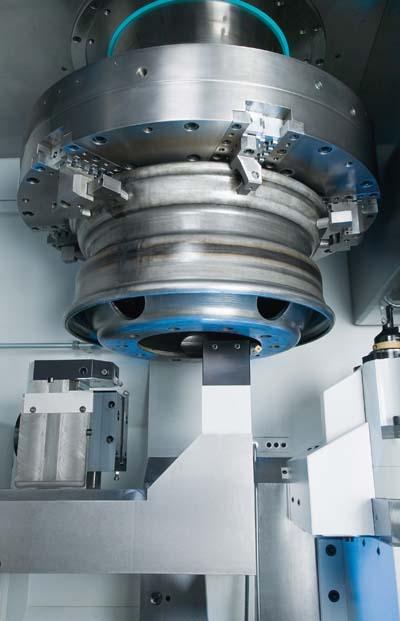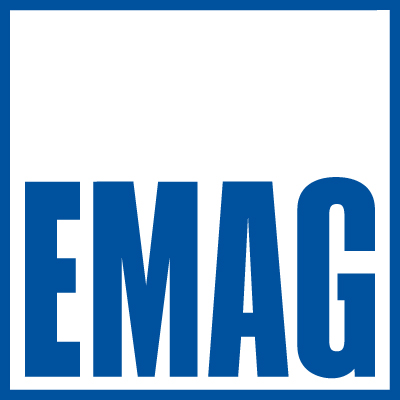
The larger the component, the smaller the batch size. This is typically the case with heavy-duty machining in many branches of the industry. In fact, this provides as much of a challenge to wind turbine engineering and the production of large commercial vehicles as it does to the railway industry. Many of the very large components are not only produced in small batches, but are also expected to be produced with the highest quality. Existing multi-stage, unnecessarily complex production processes do not work in favor of these demands, because every re-clamping of the workpiece represents an inherent danger to process integrity and component quality. The multi-functional VLC production centers from EMAG follow a totally different and more efficient approach in heavy-duty machining. Workpieces of up to 1,200mm diameter and a weight of 1,500 kg are machined vertically, in a single set up, and on one machine that accommodates a number of different machining processes and includes automation.
Heavy-duty machining is booming. Wind turbine construction in China and Europe is one industry that is responsible for this boom, another is the increasing output of commercial vehicles in almost all relevant markets, from South America to Asia. According to the foreign trade experts at Germany Trade and Invest (GTI) Brazil's production in HGVs rose by over 12 percent during the first half of 2011 compared to the same period the previous year. In China, the production of HGVs tripled from 2009/2010. The railway construction industry of some countries also has a chance at considerable growth. For instance, the GTI estimates that Russia will be investing over 85 billion Euro in its railway system before they host the soccer world championships there in 2018.
What do these industries have in common when discussed in the context of heavy-duty machining requirements? Whether we are talking planetary gear carriers for wind turbines, brake discs for commercial vehicles, or railway wheels, the demands are very similar. Components must pass several complicated quality test because all these parts will be exposed to extreme stress when in service. Take a wind turbine, for example: it is in service for an average of 120,000 hours and exposed to varying wind conditions for 20 or more years. But its production must be flexible, despite relatively small numbers; and the production tools used should be adaptable for the machining of other components, without complex conversion work.
Meeting the requirements of heavy-duty machining with the help of a compact production system concept is not an easy assignment. Many companies use complex, interlinked, multi-stage processes to machine large workpieces. The VLC production centers from EMAG, however, rely on a totally different approach. Not only do the machines load themselves, with the help of a pick-up spindle, but the machining area accommodates all necessary machining processes, turning, drilling, milling, grinding, gear hobbing, on the same machine, and in a single setup. To accomplish this, the production center is equipped with an automatic turning tool receptor, milling spindle and tool changer. The single set up ensures dimensional accuracy and a constantly maintained, excellent surface finish.
At the top of EMAG's range of heavy-duty machining centers is the VLC 1200. It handles workpieces up to 1,200mm diameter and 1,500 kg in weight. "Despite having to handle these enormous components, the production center displays the same qualities as all the vertical pick-up machines from EMAG," explains Markus Woitsch, Business Unit Manager Application Engineering. To be able to explain the success of the VLC machines in the heavy-duty machining circles it is important to take a closer look at the basic construction of this machine series. The spindle carrying the workpiece is positioned vertically above the tool, which allows the chips to fall unobstructed into a conveyor located below, from there they are transported out of the machining area. This prevents the hot chips from heating up the workpieces and contaminating the workspindle. "This is a great advantage especially in a lightly-manned, fully automated, heavy-duty machining environment," confirms Markus Woitsch. Another successful feature of this kind of heavy-duty machining is the quality control. Sourcing of the raw-parts is where the heavy investment starts; mistakes made during the production process would result in high and unnecessary costs. The answer from the designers of the VLC series to this challenge is highly sophisticated one: a probe with an accuracy of 2µm measures and checks the workpieces in-between machining operations.
Some of the advantages of the VLC are explained by the following two application examples:
One manufacturer uses an EMAG VLC 500 in the production of components for the nacelle of a wind turbine. Batch sizes are approximately 120 per week. Production of the six different components calls for up to 12 different tools. "These numbers show the flexibility of the machine. Without time-consuming modifications, the VLC 500 is capable of machining a number of totally different constituent components," emphasizes Markus Woitsch. "Furthermore, the wind turbine specification calls for a particularly high degree of component quality, which we can guarantee with the VLC."
An EMAG VLC 1200 that complete-machines railway wheels and brake discs has to carry a weight of three metric tons, including the chuck at the spindle nose. The production center also incorporates a chain magazine for 36 tools. High feed rates in the X- and Z-axes of the work spindle and a maximum torque of 13,000 Nm lead to short throughput times. "This enormous amount of power, the integral pick-up automation and the intelligent combination of diverse machining applications in a single set up have enabled us to reduce throughput times by up to 80 percent, compared to previously used processes," confirms Markus Woitsch.
The advantages of a multi-function concept have a positive effect also on the production of components for construction machinery, HGVs and agricultural machines. Compared to the traditional shop floor production of such components on three or four machines, the work load is reduced significantly when there is only the VLC to set up. "It makes a big difference whether I have to set up three or four machines for the production of 10 components, or just one," explains Markus Woitsch.
One of the determining factors in the success of the VLC series, over a hundred of these machines are already being used worldwide, is their modular design. Every machine is configured to suit the user's particular production requirements. There are many possibilities: one or two turrets, the integration of the grinding and hard machining processes and the different workpiece capacities of the VLC 500, VLC 800 and VLC 12200.
Contact Details
Related Glossary Terms
- centers
centers
Cone-shaped pins that support a workpiece by one or two ends during machining. The centers fit into holes drilled in the workpiece ends. Centers that turn with the workpiece are called “live” centers; those that do not are called “dead” centers.
- chuck
chuck
Workholding device that affixes to a mill, lathe or drill-press spindle. It holds a tool or workpiece by one end, allowing it to be rotated. May also be fitted to the machine table to hold a workpiece. Two or more adjustable jaws actually hold the tool or part. May be actuated manually, pneumatically, hydraulically or electrically. See collet.
- feed
feed
Rate of change of position of the tool as a whole, relative to the workpiece while cutting.
- gang cutting ( milling)
gang cutting ( milling)
Machining with several cutters mounted on a single arbor, generally for simultaneous cutting.
- grinding
grinding
Machining operation in which material is removed from the workpiece by a powered abrasive wheel, stone, belt, paste, sheet, compound, slurry, etc. Takes various forms: surface grinding (creates flat and/or squared surfaces); cylindrical grinding (for external cylindrical and tapered shapes, fillets, undercuts, etc.); centerless grinding; chamfering; thread and form grinding; tool and cutter grinding; offhand grinding; lapping and polishing (grinding with extremely fine grits to create ultrasmooth surfaces); honing; and disc grinding.
- milling
milling
Machining operation in which metal or other material is removed by applying power to a rotating cutter. In vertical milling, the cutting tool is mounted vertically on the spindle. In horizontal milling, the cutting tool is mounted horizontally, either directly on the spindle or on an arbor. Horizontal milling is further broken down into conventional milling, where the cutter rotates opposite the direction of feed, or “up” into the workpiece; and climb milling, where the cutter rotates in the direction of feed, or “down” into the workpiece. Milling operations include plane or surface milling, endmilling, facemilling, angle milling, form milling and profiling.
- modular design ( modular construction)
modular design ( modular construction)
Manufacturing of a product in subassemblies that permits fast and simple replacement of defective assemblies and tailoring of the product for different purposes. See interchangeable parts.
- quality assurance ( quality control)
quality assurance ( quality control)
Terms denoting a formal program for monitoring product quality. The denotations are the same, but QC typically connotes a more traditional postmachining inspection system, while QA implies a more comprehensive approach, with emphasis on “total quality,” broad quality principles, statistical process control and other statistical methods.
- turning
turning
Workpiece is held in a chuck, mounted on a face plate or secured between centers and rotated while a cutting tool, normally a single-point tool, is fed into it along its periphery or across its end or face. Takes the form of straight turning (cutting along the periphery of the workpiece); taper turning (creating a taper); step turning (turning different-size diameters on the same work); chamfering (beveling an edge or shoulder); facing (cutting on an end); turning threads (usually external but can be internal); roughing (high-volume metal removal); and finishing (final light cuts). Performed on lathes, turning centers, chucking machines, automatic screw machines and similar machines.

